Uplink Capacity Estimation and Enhancement in WCDMA Network
Автор: Fadoua Thami Alami, Noura Aknin, Ahmed El Moussaoui
Журнал: International Journal of Information Technology and Computer Science(IJITCS) @ijitcs
Статья в выпуске: 9 Vol. 5, 2013 года.
Бесплатный доступ
Uplink planification in a WCDMA network consists of estimating the maximum capacity that a cell can support, by using the quality of service equation designed by (E_b)/(N_0). We are interested in this work on two different scenarios: an isolated cell and multiple cells. This capacity is adversely affected by interferences due to own mobile stations and to others belonging to neighboring cells. In order to enhance capacity and minimize the blocking probability of new requests in the cell, we have proposed a Freeing Resources algorithm which consists of releasing some mobile stations in the handover area with the overloaded cell. This algorithm is based on freeing 1, 2 and 3 mobile stations of 12.2 kbps and 1 mobile station of 64 kbps.
WCDMA, Uplink, Maximum Capacity, Multi-Service Network, Isolated Cell, Multiple Cells, Interferences, Blocking Probability
Короткий адрес: https://sciup.org/15011958
IDR: 15011958
Текст научной статьи Uplink Capacity Estimation and Enhancement in WCDMA Network
Published Online August 2013 in MECS
In WCDMA cell, all users share the same bandwidth. Thus, each new connection increases the interference level for the ongoing connections, by affecting their quality of service expressed in terms of E b /N 0 . In addition, interference due to mobile stations (MSs) belonging to neighboring cells affects negatively the maximum cell capacity, and increases the requirements of mobile stations in terms of transmission power.
In this paper, we evaluate the effect of other-to-own-cell interference on Uplink capacity and we propose an algorithm to reduce the blocking probability of the new requests.
The remaining of this paper is organized as follows. In section 2 we intend to show, the tradeoff between
-
II. Uplink Capacity and Coverage Estimation in a Multi-Service Network
-
2.1 Mobile Station Transmission Power Expression in the Case of an Isolated Cell
The minimum E b /N 0 required for a user ( i ) in the Uplink direction, in the case of an isolated cell, can be expressed by [1,7]:
E b W P r , i
N 0 i R i P n + P own - P , i
And:
own
N
= Z P r ,i
i = 1
P t ,i =
PN
where:
-
■ P ri is the Node B received power from the user( i ).
-
■ N is the number of user in the cell.
-
■ P own is the total own-cell interferences received power at the Node B. It depends on the distribution of user in the cell and propagation conditions.
-
■ PN is the thermal noise power at the Node B.
From (1), the minimum required received power for a user ( i ) at the Node B, by taking into account the activity factor vi , is expressed as:
P r , i
Pn + Pown
W
E + 1
Eb ) R v
N ii i
Therefore, from (2) and (3), the total own-cell interferences received power at the Node B is given by:
W
Eb ) Rv N0iii
-
2.2 Uplink Cell Capacity in the Case of an Isolated Cell
-
2.2.1 Noise Rise and cell loading factor expressions
The Uplink capacity depends on the NR factor generated by users, belonging to the serving cell. During the dimensioning phase of a cellular radio mobile network, an operator must limit the maximum cell load respecting a NR threshold.
Noise Rise factor is defined as the ratio between the Node B total received power, Ptot, and the thermal noise power of the Node B, PN [2- 4]:
P own
N 1
P N 2 w :
i = 1 e ---------+1
Eb ) R v
N ii i
NR =
P N
N
1 ^ W .
i = 1 Ё--------+1
Eb ) R vN iii
Consequently, (3) can be rewritten as:
P r ,i =
In the case of an isolated cell, Ptot expression is given as:
P tot = P own + P n (8)
Thus:
P + P
NR = -w= ---^ (9)
P
N
P N
W
+
Eb ) Rv
N 0
If the cell is 100% loaded, the NR factor tends to an infinite value. Therefore, the relationship between NR and the cell loading factor is:
NR
1 - ^ UL
Therefore, the required Node B is expressed as:
transmitted power
at the
Therefore:
P n = own
'UL p + p r own + 1 N
Consequently:
N
VUL = £ i =1
W
E + 1
Eb ) R v
N ii i
n,,, .Therefore, the mobile station maximum
UL _max
transmission power is :
The Uplink cell loading factor must verify the following condition:
L i _max
P „ = t,i_max
P N
N
z -V— <1' =1 TW---+ 1
N E b ) i R i v i
Thus:
Therefore, for N users activating the same service, the Uplink capacity is limited to the following inequality:
N <
W
Eb ) R v
N ii i
+1
So, if n approaches to 1, the system reaches its pole capacity and becomes unstable. The total received power at the Node B becomes very larger than the thermal noise power, and decoding process at the Node B is no longer possible. We must therefore define a maximum value that the cell loading factor fUL _max ° must not exceed:
^ UL — ^ UL max
2.2.2 Coverage and capacity tradeoff in the case of an isolated cell
Equation (6) can be expressed as:
Pti = L
P N
From this expression we deduce that, when the cell load increases, the required transmission power for the MS will be important. In addition, since the available power at the MS is limited, the cell loading factor on the Uplink direction must be monitored to ensure the coverage provided. This control should be performed according to the maximum transmission power of the MS P and the maximum pathloss L , thus t,i_max i _max , obtaining a maximum permissible cell loading factor
W
Eb ) Rv N0iii
^ UL max
+ 1 ( 1 - ^ UL _max )
p
= 1 NL
P t,i_max
L i _max
W
+
Eb ) Rv
N 0
The previous equations illustrate the tradeoff between coverage and capacity. On the other hand, the cell loading factor in Uplink limits the maximum allowable pathloss as shown in the following equation [1]:
L i
max
To investigate the Uplink capacity in the case of multiple cells, we will treat the above equations by introducing other-cell interferences caused by neighboring cells. [1]. Thus, the expression of Eb/N0 becomes:
E b W P r , i
N0' Rt PN + (1 +fUL )Pown — Pr,.
And:
P tot = PN + C1 + f UL ) Pown (21)
Where :
f UL
P other
P own
N
Z Pr ,j j =1
N
Z P,, i =1
Is the other-to-own-cell interference and Pother is the total received power from users connected to neighboring cells. Consequently, Node B received power from the user ( i ) becomes:
N
Пи, = (1 +fUL )Ё i =1
P r , i
_ P N + (1 + f u, ) P own
W
E +1
Eb ) R v
N ii i
W
E + 1
Eb ) R v
N ii i
Therefore, the total own-cell interferences received
From this equation, we can note that the cell loading factor, in the case of multiple cells, depends on the factor fUL , the number of users in the cell and the type of service. The Uplink cell loading factor must verify the following condition:
power at the Node B is rewritten as:
N 1
P N ^7
i = 1T W + 1
Eb ) R v iii
N 0
own Ni
1 - (1 +f UL )^
i =1
Eb ) R vN iii
N
Z (1 + f u, )
i = 1
W
F +
EbN )i ivi
< 1
Thus, the Uplink capacity is limited to the following inequality:
N <
Then, the final expression of P r,i in the case of several cells is expressed as :
W
Eb ) R vN iii
1 1 + f )
P = r , i
P N
The Uplink capacity is the maximum number of users when the cell loading factor has reached its maximum value. Therefore:
W
Eb ) Rv
N iii

1 - О + U ) £~ W--- i =1 --------- + 1
Eb ) Rv N iii
N
Max
W
E
Eb ) Rv i ii
N 0
П и, _max
1 + f u, )
Therefore, the mobile station required transmission power is:
From (27), the Noise Rise expression is given as:
P , i =
L i
P N

N
NR =----------- 1----77------ (31)
1 — (1 + f UL )---- W—
1 + E Eb ) Rv i ii N 0
W
1 - (1 + fuL ) Z = 1
W
E +1
E b ) Rv Niii
2.3.2 Capacity and coverage trade-off in the case of multiple cells
Similarly to the case of an isolated cell, the maximum allowable path loss is given by:
-
2.3.1 Uplink cell capacity and Noise Rise expressions in the case of multiple cells
In the case of multiple cells, the cell loading factor expression is:
L i _max
P t,i_max
P N
W
Eb ) Rv
N iii
(1 - Пл. ) (32)
the Noise Rise calculated after the admission of the new request, and by NRmax , the maximum Noise Rise set by the operator in the dimensioning phase. To avoid the overloading situation, the following constraint must be satisfied:
Where п is expressed in (27).
NR III. Admission control algorithms In Uplink, we are interested on two admission control algorithms. The first one is based on the cell loading factor n [5, 7, 10— 11], presented in (12) in the case of an isolated cell and in (27) in the case of multiple cells. Assuming there are N users simultaneously active in the cell, the (N+1)th request will be accepted if the following condition is satisfied: Пи.+АП ^ П. max Пь is the cell loading factor measured during a period T where N users are active. An is the cell loading factor increase due to the (N+1)th user. Пл max is the maximum cell loading factor. In the case of an isolated cell An parameter is expressed by: An = W E + b N ) N +1 RN +1vN +1 N0 And in the case of multiple cells, An becomes: д„ =lb') ' W, E b ■XT ) N +1RN +1v N +1 N0 The goal of admission control is to ensure good quality of service for the new request as well as for connections already established. If nUL +An > Пщ, „„ , an unstable situation is brought about, in form of cuts in some existing communications, caused by the high level of interference in the cell. The second method of admission control in Uplink is based on the NR factor [5, 6, 8, 9]. We denote by NRnew The aim of this algorithm is to reduce the interferences level taking place in the overloaded cells, by asking mobile stations located in the handover area to stop communicating with them. When a cell is in an overloading situation, the Node B initiates the process of Freeing Resources (FR) in order to be able to accept the new request. In fact, when a MS appears in the cell, the cell loading factor increases with An . When the new load exceeds the maximum value, the Node B initiates the FR mechanism in order to alleviate the load. Consequently two situations will be presented: 1- If no MS is in the overlapping area, the mechanism will be unable to release the radio resources in the overloaded cell and therefore the new request will be rejected. 2- If there are mobile stations in the overlapping area and if the call is disconnected with some of them, the Node B in the overloading cell recalculates the new load by estimating the cell load factor increase due to new request, to see if the admission constraint is checked to accept the new request. Otherwise the request is rejected. Let Start with an empty network. Users are added to the system until the target value of the initial cell loading factor is reached. When a new request arrives, the admission control algorithm decides whether the user will be accepted or not based on the new estimated load. If the load is less than or equal to the maximum cell loading factor, the user is accepted. If the network is already overloaded, the system searches if there are mobile stations in handover areas. If the overlapping area contains no mobile station, the new user is rejected. If there is a mobile station in handover situation, the system cuts off its communication with the overloaded cell and the number of simultaneously active users in the cell is reduced. If (33) is satisfied, the call is accepted, otherwise it is rejected. The following diagram summarizes the algorithm described above: Fig. 1: Freeing Resource algorithm The simulation parameters taken into account are listed in the table bellow [1]: Table 1: Simulation parameters Parameters Values W (chip rate) 3.84 Mcps R (voice) 12.2 kbps R (data) 64 kbps Eb/N0 (voice) 5 dB Eb/N0 (data) 3 dB v (voice) 0.67 v (data) 1 ful 0.67 t,i_max 125 Mw Fig. 2: Maximum coverage as a function of η In addition, we notice that, the higher the bit rate is, the weaker the coverage becomes, which is due to the increase in transmission power need of the MS. Fig. 3: Eb/N0 as a function of number of users From Fig. 3, we note that in the case of a single cell, we can accept up to 85 users activating the voice service, while in the case of multiple cells, we can only accept 50 users. Therefore we can conclude that the presence of other-cell interferences adversely affect the capacity. Fig. 2 shows that, if the cell loading factor increases, the coverage decreases and inversely, resulting in the phenomenon of cell respiration. Fig. 4: Cell loading factor in the case of voice service Fig. 6: Noise Rise factor as a function of the number of users From Fig. 4, we see that if /д, ^ = 0.6 , the maximum number of users activating voice that a cell can support, in the case of an isolated cell, is approximately 90 users, while in the case of multiple cells, the maximum number of users supported is approximately equal to 54. From this figure, we note that the Noise Rise factor increases with the number of simultaneously active users in the cell. In fact, for NR_max= 4 dB, corresponding to the maximum cell loading factor Пиь max = 0,6 , we notice the same results found in Fig. 5 and Fig. 6. Therefore the operator is based on one of these two parameters to determine the maximum capacity that can support a cell. Fig. 5: Cell loading factor in the case of voice/ data Fig. 7: Mobile station transmission power in the case of voice service In the case of two services: voice and data, Fig. 5 shows that, for Пь max = 0,6 the maximum number of users supported in the case of an isolated cell is approximately 34 users, while in the case of multiple cells, the number of users supported is approximately 20. In addition, according to the two figures, for a given value of maximum cell loading factor, we note that, the maximum cell capacity supported by the cell in the case of multi-service network is lower than that supported by a cell activating voice, in the two studied scenarios. The following figure shows the variation of NR as a function of simultaneously active users, in the case of voice and in the case of two services: voice/ data, for two different scenarios. : Fig. 8: Mobile station transmission power in the case of voice/ data services From Fig. 7 and Fig. 8 we note that, for the same number of simultaneously active users in the cell, the mobile station required transmission power in the case of an isolated cell, is lower in comparison with that required in the case of multiple cells. The value of this power in the case of 64 kbps data rate, for a very small number of users, is higher than in the case of 12.2 kbps data rate. In addition, the difference in power requirement between the two scenarios increases when the number of users in the cell becomes important. This is explained by the increase in interference level received at the Node B, which seeks a high power level to achieve the desired signal quality. Consider a 3G network already containing 62 users activating voice, where /д, ^ = 0,7. The variation of the blocking probability as a function of the new requests in the case of the multiple cells case is shown in the following figure: From this figure, we see that the blocking probability increases significantly with the number of new requests seeking access to the cell. Fig. 9: Blocking probability as a function of new requests Fig. 10 shows the blocking probability obtained by using the FR algorithm, with liberation of 1, 2 and 3 mobile stations activating voice, in the case of new requests of 12.2 kbps. Fig. 10: Blocking probability as a function of new requests in the case of releasing 1 , 2 and 3 MSs of 12.2 kbps in the case of voice From this figure, the blocking probability of new requests of 12.2 kbps, decreases with the number of released mobile stations, activating the voice service. Fig. 11 and Fig. 12 show respectively, the blocking probability of new requests of 12.2 kbps, in a multiservice network, in the case of liberation of 1,2 and 3 mobile stations of 12.2 kbps data rate, and in the case of liberation of a single MS of 64 kbps data rate. Number of request Fig. 11: Blocking probability as a function of new requests in the case of releasing 1 , 2 and 3 MSs of 12.2 kbps in the case of voice/ data 0.7 0.6 0.5 £ -О- Without freeing resources algorithm -•-freeing 1 mobile station of 64 kbps 0.4 0.3 Num5ber of requ6est Fig. 12: Blocking probability as a function of new requests in the case of releasing one MS of 64 kbps in the case of voice -О- fUL=0.67 ■•♦• fUL=0.9 number of requests less than or equal to 8, and decreases it considerably when it exceeds 8 requests in comparison with the case of releasing 1 and 2 MSs activating voice. From Fig. 12, we note that, releasing a single MS of 64 kbps, cancels the blocking probability even for 10 requests. In Fig. 13, we represent the variation of blocking probability according to the number of new requests of 12.2 kbps in the case of an isolated cell, and in the case of multiple cells for two values of other-to-own-cell interference factor. We note that the blocking probability for fUL= 0.9 is very high, while that obtained with fUL= 0.67, for a number of requests ranging from 1 to 10, is null. According to these results, we conclude that the high interference level caused by neighboring cells increases the blocking probability of new requests. In this work, we studied the effect of other-to-own-cell interference on the WCDMA cell uplink capacity, in the case of voice and in the case of two services: voice and data of 64 kbps. We are interested on two different scenarios: an isolated cell and multiple cells. We have shown that the maximum capacity obtained in the case of an isolated cell is approximately twice that obtained in a scenario of multiple cells. Then, we demonstrated that the required transmission power for mobile station in the case of an isolated cell is lower than that obtained in the case of multiple cells. In addition, we proposed a Freeing Resources algorithm that is based on stopping communication of some mobile stations located in the handover area, with the overloaded cell, taking advantage of the multiple connections that the MS establishes with Node Bs serving the overlapping area. From the results obtained, we found that the release of canal of a single MS of 64 kbps data rate cancels the blocking probability of new applications, which demonstrates the effectiveness of this algorithm for an interval from 1 to 10 requests. In addition, we found that a high value of other-to-own cell interference increases the blocking probability of new requests and thus limits the Uplink capacity. Number of request Fig. 13: Blocking probability as a function of new requests in the case of releasing one MS of 64 kbps for two values of fUL From Fig. 11, the release of three mobile stations activating voice cancels the blocking probability for a [1] Jordi Pérez-Romero, Oriol Sallent, Ramon Agusti, Radio Resource Management Strategies In UMTS, All of Universitat Polite`cnica de Catalunya (UPC), Spain, Miguel Angel Diaz-Guerra Telefonica Moviles Espana, S.A., Spain. [2] Settapong Malisuwan et al., Uplink Capacity of mobile all-packet-service WCDMA Internet systems in emi environment, Proc. IEEE Int. Symp. Electromag. Compat, Japan, 2004. [3] José Outes Carnero, Uplink Capacity Enhancement in WCDMA, Multi Cell Admission Control, Synchronised Schemes and Fast Packet Scheduling, ISBN 87-90834-54-2, ISSN 0908-1224, R04- 1011,Department of Communication Technology, Institute of Electronic Systems, Aalborg University, Niels Jernes,, March 2004. [4] Thrasivoulos (Sakis) Griparis, Tristan Lee, The capacity of WCDMA network: With box study, Bechtel Telecommunications Technical Newspaper, vol. 3, No 1, august 2005.Texas Wireless Symposium 2005. [5] Zdeněk RŮŽIČKA, Stanislav HANUS, Admission Control And Load Control In UMTS Network, Institute of Radio Electronics, Brno University of Technology Purkyňova 118, 612 00 Brno, Czech Republic . [6] Erik Geijer Lundin, Uplink Admission Control Based on Estimated Interference in WCDMA Systems, Master’s Thesis completed at Communication Systems,Linköpings Universitet, Sweden. [7] Salman Al-Qahtani and Ashraf Mahmoud, Uplink Admission Control in WCDMA, International Symposium on Wireless Communications (ISWSN'05) 2005. [8] Thamer Al-Meshhadany, The impact of Soft handoff on the Uplink capacity in WCDMA systems Thamer Al-Meshhadany, Computer Communications 29 (2006) 3804–3811. [9] S. A. El-Dolil, A. Y. Al-nahari, M. I. Desouky and F. E. Abd El-samiem Uplink Power Based Admission Control In Multi-Cell WCDMA Network With Heterogeneous Traffic, Progress In Electromagnetics Research B, Vol. 1, 115–134, 2008, Department of Electronics and Electrical Communications Faculty of Electronic Engineering Menoufia University Menouf, Egypt. [10] Rachod Patachaianand, Kumbesan Sandrasegaran, Simulation of Call Admission Control in MultiTraffics WCDMA System, Institute of Information and Communication Technologies and Faculty of Engineering, University of Technology Sydney (UTS). [11] Abdullah Al Muzahid, Ahmed Khurshid, Md. Mostofa Ali Patwary, Md. Mostofa Akbar, Reservation Based Adaptive Uplink Admission control for WCDMA, Department of CS of CS Faculty of Science and Technology in Tangier Morocco in 2004 and the Desa degree in Telecommunications System from Faculty of Science of Tetuan in November 2006 and is currently pursuing the Ph.D.degree. Noura AKNIN, received the Licence in Physics and the PhD degree in Electrical Engineering, respectively, in 1988 and 1998 from Abdelmalek Essaadi University in Tetouan, Morocco. She is a Professor of Telecommunications and Computer Engineering in Abdelmalek Essaadi University since 2000. She is the Co-founder of the IEEE Morocco Section since November 2004. She has been a member of the Organizing and the Scientific Committees of several symposia and conferences dealing with RF, Mobile Networks, Social Web and information technologies. Prof Noura AKNIN is a member of IEEE Communications Society and Computer Society. Her research interests focus mainly on Wireless and mobile communication systems, radio network planning and optimization. Ahmed EL MOUSSAOUI, received the PhD degree in electronics at the university of BRADFORD in 1990. In 2007 he received the international master in E-learning in the Curt Bosh institute in Switzerland. He has been a member of the Organizing and the Scientific Committees of several symposia and conferences dealing with RF, Mobile Networks and information technologies. He has participated in several project with France and spain. His research interests are: electronic engineering, third generation mobile system, radio network planning and optimization. Fadoua THAMI ALAMI, received the licence in computer science from Abdlmelek Essaidi university,3.1 The Effect of Admission Control on Uplink Capacity
3.2 Freeing Resources Algorithm
3.3 The proposed Algorithm
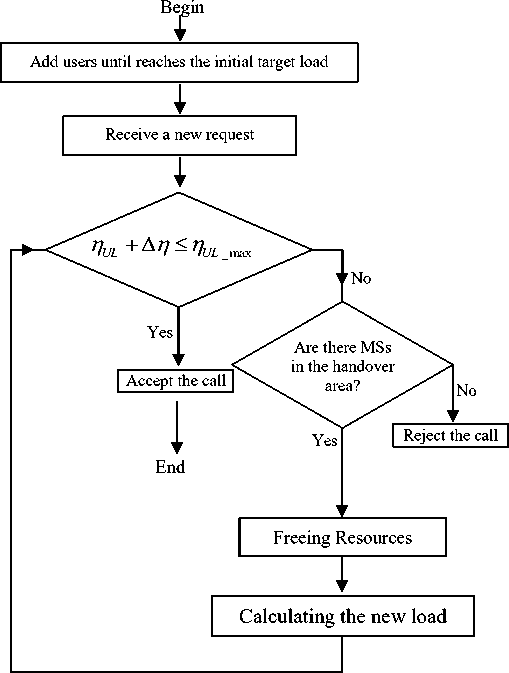
IV. Simulation Parameters
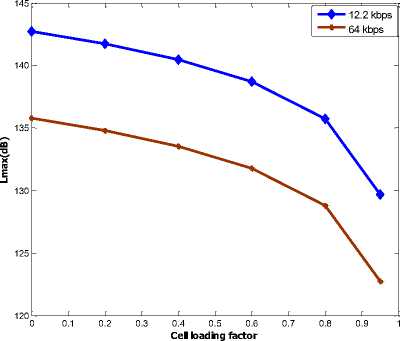
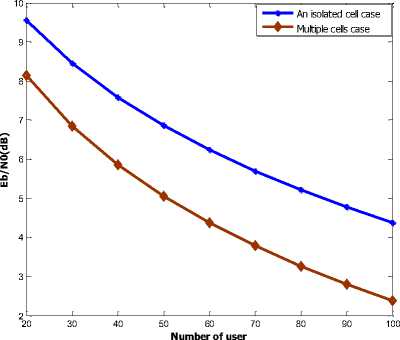
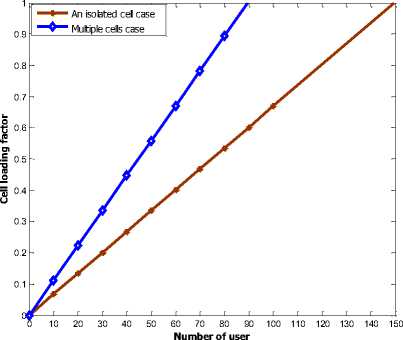
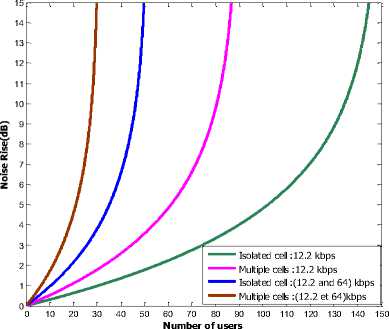
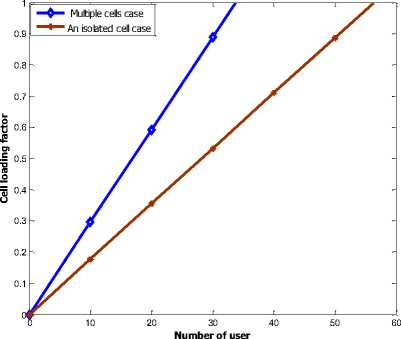
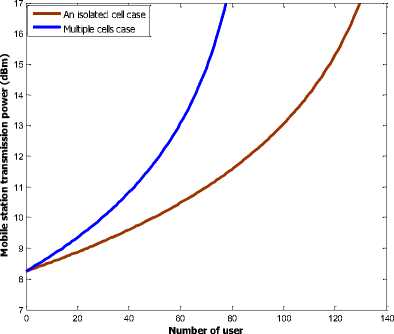
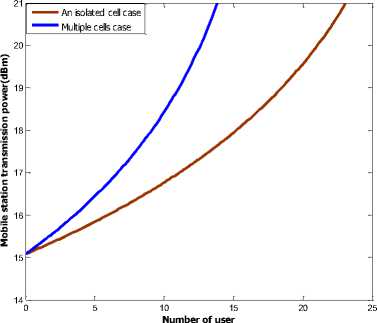
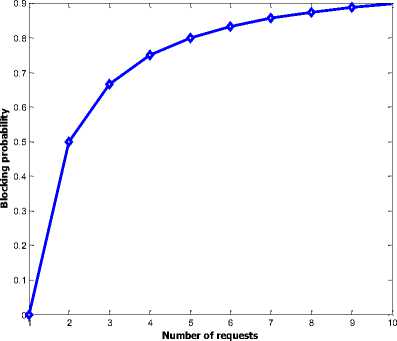
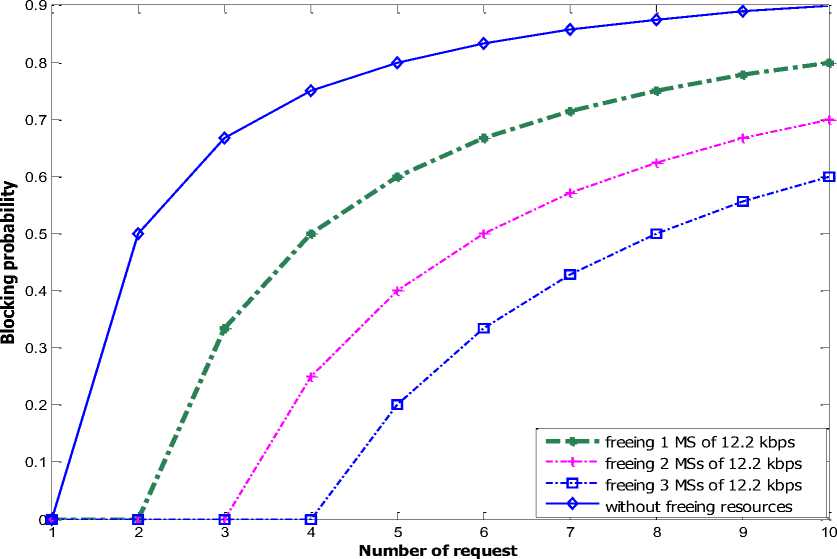
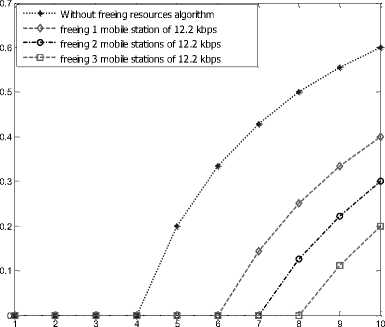
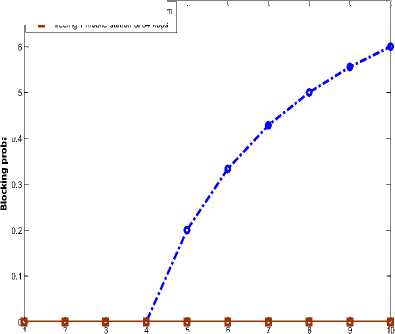
V. Conclusion
Список литературы Uplink Capacity Estimation and Enhancement in WCDMA Network
- Jordi Pérez-Romero, Oriol Sallent, Ramon Agusti, Radio Resource Management Strategies In UMTS, All of Universitat Polite`cnica de Catalunya (UPC), Spain, Miguel Angel Diaz-Guerra Telefonica Moviles Espana, S.A., Spain.
- Settapong Malisuwan et al., Uplink Capacity of mobile all-packet-service WCDMA Internet systems in emi environment, Proc. IEEE Int. Symp. Electromag. Compat, Japan, 2004.
- José Outes Carnero, Uplink Capacity Enhancement in WCDMA, Multi Cell Admission Control, Synchronised Schemes and Fast Packet Scheduling, ISBN 87-90834-54-2, ISSN 0908-1224, R04-1011,Department of Communication Technology, Institute of Electronic Systems, Aalborg University, Niels Jernes,, March 2004.
- Thrasivoulos (Sakis) Griparis, Tristan Lee, The capacity of WCDMA network: With box study, Bechtel Telecommunications Technical Newspaper, vol. 3, No 1, august 2005.Texas Wireless Symposium 2005.
- Zdeněk RŮŽIČKA, Stanislav HANUS, Admission Control And Load Control In UMTS Network, Institute of Radio Electronics, Brno University of Technology Purkyňova 118, 612 00 Brno, Czech Republic .
- Erik Geijer Lundin, Uplink Admission Control Based on Estimated Interference in WCDMA Systems, Master’s Thesis completed at Communication Systems,Linköpings Universitet, Sweden.
- Salman Al-Qahtani and Ashraf Mahmoud, Uplink Admission Control in WCDMA, International Symposium on Wireless Communications (ISWSN'05) 2005.
- Thamer Al-Meshhadany, The impact of Soft handoff on the Uplink capacity in WCDMA systems Thamer Al-Meshhadany, Computer Communications 29 (2006) 3804–3811.
- S. A. El-Dolil, A. Y. Al-nahari, M. I. Desouky and F. E. Abd El-samiem Uplink Power Based Admission Control In Multi-Cell WCDMA Network With Heterogeneous Traffic, Progress In Electromagnetics Research B, Vol. 1, 115–134, 2008, Department of Electronics and Electrical Communications Faculty of Electronic Engineering Menoufia University Menouf, Egypt.
- Rachod Patachaianand, Kumbesan Sandrasegaran, Simulation of Call Admission Control in Multi-Traffics WCDMA System, Institute of Information and Communication Technologies and Faculty of Engineering, University of Technology Sydney (UTS).
- Abdullah Al Muzahid, Ahmed Khurshid, Md. Mostofa Ali Patwary, Md. Mostofa Akbar, Reservation Based Adaptive Uplink Admission control for WCDMA, Department of CS.


